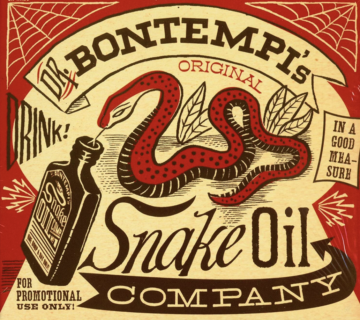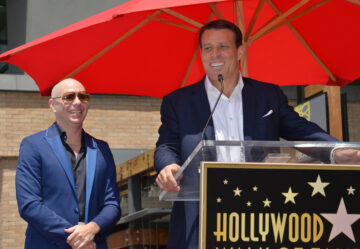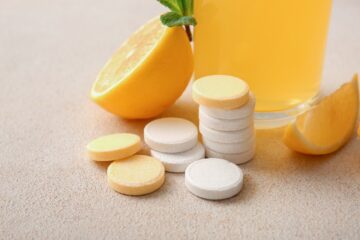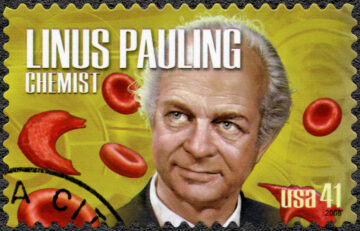by Mark Harvey
 Vitamins and self-help are part of the same optimistic American psychology that makes some of us believe we can actually learn the guitar in a month and de-clutter homes that resemble 19th-century general stores. I’m not sure I’ve ever helped my poor old self with any of the books and recordings out there promising to turn me into a joyful multi-billionaire and miraculously develop the sex appeal to land a Margot Robbie. But I have read an embarrassing number of books in that category with embarrassingly little to show for it. And I’ve definitely wasted plenty of money on vitamins and supplements that promise the same thing: revolutionary improvement in health, outlook, and clarity of thought.
Vitamins and self-help are part of the same optimistic American psychology that makes some of us believe we can actually learn the guitar in a month and de-clutter homes that resemble 19th-century general stores. I’m not sure I’ve ever helped my poor old self with any of the books and recordings out there promising to turn me into a joyful multi-billionaire and miraculously develop the sex appeal to land a Margot Robbie. But I have read an embarrassing number of books in that category with embarrassingly little to show for it. And I’ve definitely wasted plenty of money on vitamins and supplements that promise the same thing: revolutionary improvement in health, outlook, and clarity of thought.
On the face of it, there’s nothing wrong with self-help. I think one of the most glorious and heartening visions in the world is that of an extremely overweight man or woman jogging down the side of the road in athletic clothing and running shoes. When I see such a person, I say a little atheist prayer hoping that a year from now they have succeeded with their fitness regime and are gliding down the Boston Marathon, fifty pounds lighter. You never know how they decided to buy a pair of running shoes and begin what has to be an uncomfortable start toward fitness. But if it was a popular book or inspirational YouTube video that nudged them in that direction, then glory be!
The same goes with alcoholics and drug addicts. Chances are, millions are bucked up by a bit of self-help advice from a recovering addict or alcoholic, an inspirational quote they read, and even certain supplements to help their bodies heal from abuse.
But so much of what’s sold as life-changing does little more than eat at a person’s finances in little $25 increments of shiny books and shiny bottles. Sometimes the robberies are bigger—thousands of dollars in the form of fancy seminars, retreats, or involved online classes. There are thousands of versions of snake oil, and there will always be people lining up for some version of it.
The very term snake oil comes from the many years in the 19th century when hucksters sold little bottles of mineral oil fobbed off as, well, snake oil. Historians surmise that the health-saving promises made by the salesmen came from the real snake oil brought to America by Chinese working on the western railways. Chinese have been using the oil from water snakes for centuries to help with arthritis. I don’t know if it works or not but real snake oil does at least have lots of Omega-3 fatty acids, which might help with cardiovascular and brain health. In 1916 when the US government finally did a chemical analysis on Clark Stanley’s Snake Oil (one of the biggest salesmen nationwide), they found it was composed of mineral oil, tallow, chili peppers, turpentine, and camphor.
I’ve never had pure snake oil, but I ate a lot of rattlesnakes when I used to lead backpacking trips in the mountains of Baja, California. There was never much meat to them, but they were delicious and kind of tasted like crab. And I once had rattlesnake pâté at a fancy wedding. We decided the pâté was chosen because it most closely resembled the bride’s character. The marriage didn’t last and none of the snake dishes ever helped my knees.
Today’s self-help runs the gamut from speed reading to weight loss to becoming a financial genius. Woody Allen captured it well when he said, “I took a speed-reading course and read War and Peace in twenty minutes. It involves Russia.”
A fair number of self-help gurus encourage us to find our inner child and give that inner child a big sloppy hug. In what was a fairly desperate time in my life, I actually tried that advice. But my inner child found my then wretched adult to be kind of creepy seeking hugs from a minor. The whole exercise left me feeling more wretched and my inner child was a little traumatized.

The behemoth in self-help is Tony Robbins, the baritone-voiced millionaire. Most of us men would always be happy to be a little bigger, a little stronger, a little more macho. But I’ve never wanted to be as big, baratony, and padded-shouldered-power-dressed as Tony Robbins. Ewww! Don’t self-help me that far! Not ready to awaken that giant within.
Robbins’ net worth is more than $500 million. That’s a lot of self-improvement. I always thought that a Tony Robbins course cost a couple of thousand dollars, and some of them do. But if you really want to awaken the platinum giant within you should probably sign up for the Platinum Membership. Here’s the cost breakdown for that: First year, $85,000 entry fee. Plus, $6,000 monthly for the first ten months and $5,000 for months 11 and 12. That’s $155,000—for the first year. If you want a second year of Platinum features, you have to pay an additional $75,000 plus $5,000 per month in months 1-12.
You’ll get a lot of Tony Robbins for that money, including exotic trips, seminars for friends, books, courses, personal coaching, and probably all the fire walking your little feet can take. Some of those fees go to The Tony Robbins Foundation, but how much is entirely at the discretion of…. Tony Robbins and crew.
One woman’s testimony from the platinum-level course is that she spent $200,000 to discover that her soul-killing pursuit of creating her own $50-million business was ruining her life. Emma Grayson came to that conclusion watching Tony Robbins on stage live and noticing that he looked very old and decrepit from running his own multi-billion-dollar operation. In short, her epiphany from the Tony Robbins Platinum Course was that she didn’t want to be like Tony Robbins. Out of curiosity, after reading her testimony, I went to her website to see what her line of business was. You guessed it: self-improvement, with the motto “Work smarter, not harder.” Tony Robbins Lite.
I’m a little skeptical by nature but the really good hucksters can still draw me in. The other day while browsing the Internet I stumbled onto a video of a guy who promised to have the secret sauce when it comes to investing in artificial intelligence. He made a compelling case for a company that has helped Ukraine fight the Russians using AI and I was ready to pull the $99 trigger to get his secret and quickly become Jeff Bezos’s peer. The kill-joy skeptic in me insisted on googling the fellow’s background and of course he was a fraud who had made dozens of faulty predictions. I was almost more disappointed not to get on that little joy ride of the latest and greatest than I was glad to have saved myself the ninety-nine bucks.
 Which brings us to vitamins and supplements. Every year Americans spend in the neighborhood of $35 billion on them. And their benefits are dubious. In an editorial titled Enough is Enough: Stop Wasting Money on Vitamin and Mineral Supplements, doctors from Johns Hopkins and other medical schools cast real shade on the vitamin and supplement industry. Reviewing 27 studies that involved more than 400,000 participants, the doctors concluded that there was no evident benefit from multivitamins, paired vitamins, or single vitamins in preventing all-cause mortality, cardiovascular disease or cancer. They further concluded from reviewing extensive studies that vitamins don’t help with cognitive decline in older adults. Try to remember that next time you’re at the pharmacy.
Which brings us to vitamins and supplements. Every year Americans spend in the neighborhood of $35 billion on them. And their benefits are dubious. In an editorial titled Enough is Enough: Stop Wasting Money on Vitamin and Mineral Supplements, doctors from Johns Hopkins and other medical schools cast real shade on the vitamin and supplement industry. Reviewing 27 studies that involved more than 400,000 participants, the doctors concluded that there was no evident benefit from multivitamins, paired vitamins, or single vitamins in preventing all-cause mortality, cardiovascular disease or cancer. They further concluded from reviewing extensive studies that vitamins don’t help with cognitive decline in older adults. Try to remember that next time you’re at the pharmacy.
Most vitamins are harmless, if expensive, but there is some fairly conclusive evidence that taking beta carotene, vitamin E, and high doses of vitamin A can shorten your life.
Tens of millions of Americans dedicated to questionable health regimens spend on average more than $500 per year on vitamins and supplements that go in and out without doing any good. As one wag put it, that’s some very expensive urine. That’s also $500 that might have been spent on a deposit for a Tony Robbins course.
 Even some of the smartest people in the world go all in on the theory that taking enough vitamins truly is a panacea. Take Nobel Laureate Linus Pauling, one of the most intelligent and accomplished men to ever walk the earth. You’ll recall that Pauling won his Nobel Prize in chemistry for his revolutionary theories on chemical bonds, uniting quantum physics with chemistry. His accomplishments as a scientist are breathtaking, but he also believed taking enough vitamin C could prevent the common cold, possibly cure cancer, and significantly extend a person’s life. At one point, Pauling was taking 18,000 milligrams of vitamin C every day, and recommended that Americans take at least 3,000 milligrams per day, which is about 40 times today’s FDA recommended dose. Pauling went on to advocate taking huge doses of vitamin A, vitamin E, and beta-carotene. From what I’ve read, there’s no evidence that massive doses of vitamin C do anything to prevent colds or cancer. And as mentioned earlier, big doses of vitamin E and beta carotene have shown to be life-shortening.
Even some of the smartest people in the world go all in on the theory that taking enough vitamins truly is a panacea. Take Nobel Laureate Linus Pauling, one of the most intelligent and accomplished men to ever walk the earth. You’ll recall that Pauling won his Nobel Prize in chemistry for his revolutionary theories on chemical bonds, uniting quantum physics with chemistry. His accomplishments as a scientist are breathtaking, but he also believed taking enough vitamin C could prevent the common cold, possibly cure cancer, and significantly extend a person’s life. At one point, Pauling was taking 18,000 milligrams of vitamin C every day, and recommended that Americans take at least 3,000 milligrams per day, which is about 40 times today’s FDA recommended dose. Pauling went on to advocate taking huge doses of vitamin A, vitamin E, and beta-carotene. From what I’ve read, there’s no evidence that massive doses of vitamin C do anything to prevent colds or cancer. And as mentioned earlier, big doses of vitamin E and beta carotene have shown to be life-shortening.
The self-help stuff that I’ve actually found helpful is kind of obscure and centers around sitting for long periods of time with as little distraction as possible. It’s called meditation. And it’s actually been described by some Buddhists as “cool boredom” or seeking “the mind of clover.” It took me a forever to accept the fact than any real benefit from meditating would take a long time. I began the practice with hopes of immediate enlightenment and achieving that glossy-eyed look, saccharine smile, and subtle superiority of people who purport to be enlightened. Needless to say, that didn’t happen…yet.
But the sometimes uncomfortable act of just sitting there watching your monkey mind go on the rampage as you try to focus on your breath is helpful. The change is incrementally tiny and goes against the American tradition of promising instant improvement. Plus because it requires very little equipment, there’s not a huge demand for saffron robes, and those actually doing the practice consistently are still in the minority, you won’t find too many hucksters selling meditating gear and promising good karma in the next life if you just take their weekend course in Atlanta. Though there are a few.
 There are some other self-help things that are free and actually work such as taking a walk in nature, spending some time with a good friend, petting your dog, or having a good laugh. The mega-dose is taking a walk in a beautiful park with a funny friend who has a good dog. Let the giant within have a rest.
There are some other self-help things that are free and actually work such as taking a walk in nature, spending some time with a good friend, petting your dog, or having a good laugh. The mega-dose is taking a walk in a beautiful park with a funny friend who has a good dog. Let the giant within have a rest.
